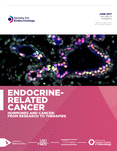Novel roles of the autocrine motility factor/phosphoglucose isomerase in tumor malignancy
- Tumor Progression and Metastasis, Karmanos Cancer Institute, Wayne State University, School of Medicine, Detroit, Michigan 48201, USA
- 1Department of General Surgical Science (Surgery I), Gunma University Graduate School of Medicine, Maebashi, 371-8511, Japan
- 2Department of Orthopedic Surgery, Gunma University Graduate School of Medicine, Maebashi, 371-8511, Japan
- (Requests for offprints should be addressed to A Raz, Tumor Progression and Metastasis, Karmanos Cancer Institute, 110 East Warren Avenue, Detroit, Michigan 48201, USA; Email: raza{at}karmanos.org.)
Abstract
Autocrine motility factor (AMF) stimulates cell motility in an autocrine manner and is related to tumor malignancy. AMF is a multifunctional molecule, also known as phosphoglucose isomerase and neuroleukin. Signal cascades of the AMF-stimulated motility and novel functions of this protein contributing to tumor malignancy have been presented recently. AMF stimulation activated small Rho-like GTPases and subsequently induced actin fiber rearrangement, which was removed by the C3 exoenzyme, a specific inhibitor of Rho. The expression of Jun N-terminal kinase (JNK)1, JNK2 and the Rho GDP dissociation inhibitor-β was upregulated by AMF. The addition of AMF to culture medium stimulated the motility of the endothelial cells and the formation of tube-like structures in collagen gels. Highly AMF-expressing HT1080 cells induced aggressive angiogenesis in vivo. The expression of fms-like tyrosine kinase (Flt)-1, a vascular endothelial growth factor (VEGF) receptor, was enhanced in AMF-expressing tumors dependent on protein kinase C and phosphatidylinositol 3 kinase (PI3K) activation; meanwhile kinase insert domain-containing receptor, another receptor of VEGF, was not. Permeability of mesothelial and endothelial cell monolayers was increased by AMF, and numerous gaps were observed in the monolayers after treatment with AMF. AMF gene transfection transformed NIH3T3 cells to proliferate quickly and acquire anti-apoptosis ability induced by serum deprivation in a PI3K-dependent manner. The anti-apoptotic effect of AMF has been described by other authors who have shown that the AMF over-expressing cells were resistant to mitomycin-C-induced apoptosis showing regression of Apaf-1 and caspase-9 dependent on PI3K and MAP kinase. These novel functions of AMF makes it a likely target for cancer therapy.
- © 2004 Society for Endocrinology












